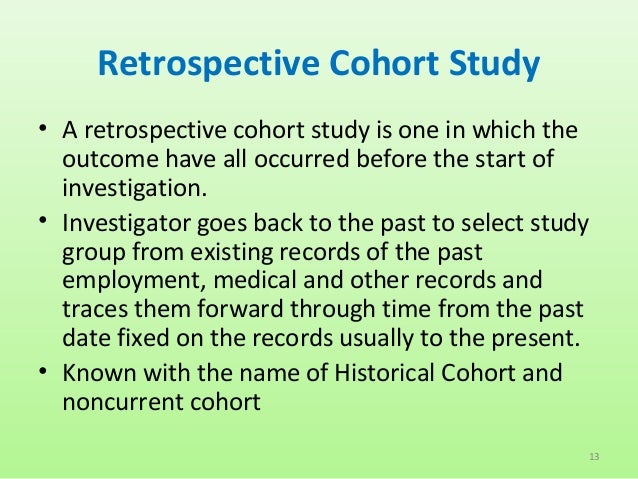
Centre for Evidence-Based Medicine, Oxford (1a-5) SORT: Strength-of-Recommendation Taxonomy (A,B,C).

Individuals who developed the outcome are compared with those who did not. Thus, poor methodology can predicate a drop in level of evidence. A retrospective study, sometimes called a historical cohort study, is a type of longitudinal study in which researchers look back to a certain point in time to analyze a particular group of subjects who have already experienced an outcome of interest. Expert opinion without explicit critical appraisal or based on physiology bench research or "first principles". Retrospective cohort designs generate the highest level of observational evidence but cannot infer any causal associations.
RETROSPECTIVE COHORT SERIES
II-3 Evidence obtained from multiple time series with or without the intervention. A guide to the development, implementation and evaluation of clinical practice. 2b Individual cohort study Individual retrospective cohort study 2c "Outcomes research" "Outcomes research" 3a Systematic review of case-control studies We conducted a register based retrospective cohort study with data on all adult patient admissions from 82 of 84 Swedish ICUs between 20, as recorded in the Swedish Intensive Care Register. Therefore, cohort studies are good for assessing prognosis. Summarises the findings of a high-quality systematic review. Individual cohort study (including low quality RCT e.g., 2 diagnostic studies: SR (with homogeneity*) of 2b and better studies: SR (with homogeneity*) of Level >2 economic studies: 2b: Individual cohort study (including low quality RCT e.g., <80% follow-up) The systematic review or meta-analysis of randomized controlled trials (RCTs) and evidence-based practice guidelines are considered to be the. The original table and related notes are available at In general, the descriptor, 'prospective' or 'retrospective', indicates when the cohort is identified relative to the initiation of the study. The aim of this study was to provide a complete picture of ICU-related transfusions in Sweden. Level I - Evidence from a systematic review or meta-analysis of all relevant randomized controlled trials (RCTs) Level II - Evidence obtained from well-designed RCTs Level III - Evidence obtained from well-designed controlled trials without randomization Level IV - Evidence from well-designed case-control and cohort studies Case series (and poor quality cohort and case-control study. MEDLINE (OVID) To limit your search results to include specific study types, click on the "Additional Limits" button at the bottom of the blue "Limits" box. Levels of evidence (or hierarchy of evidence) is a system used to rank medical studies based on the quality and reliability of their design. Evidence from a single descriptive or qualitative study. The outcome of interest was 90th percentile of costs for each year under study ('persistent high-cost use'). D: level 5 evidence or troubling inconsistent or inconclusive studies of any level.

Because exposure is identified before outcome, cohort studies are considered to provide stronger scientific evidence than other observational studies such as case-control studies. This facility, built in 1971, was designed to reduce the high levels of chr. We conducted a population-based retrospective cohort study.


 0 kommentar(er)
0 kommentar(er)
